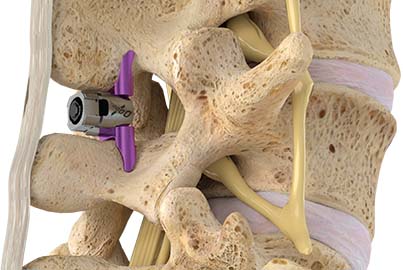
What is Lumbar Spinal Stenosis?
Lumbar spinal stenosis (LSS) is a gradual narrowing of the space in the spine where nerves pass through. The narrowing of the space can cause a pinching effect on the nerves in the lower back, which can result in an aching, dull back pain down the buttocks and into one or both legs. It is a natural degenerative condition that affects more than 14 million Americans and most commonly found in patients over 60 years of age. Lumbar Spinal Stenosis typically occurs as people age and the result of wear and tear on the spine from everyday activities. Over time, the narrowing may cause constriction of the nerves that run down the back and into the legs. This can result in pain and discomfort in your back and legs and limit your mobility.
What are the Symptoms of Lumbar Spinal Stenosis?
Symptoms of LSS may include:
- Pain while walking
- Numbness or “tingling” feeling in your legs, calves, or buttocks
- Weakness
- Loss of balance
- Aching, dull back pain spreading to your legs
- Decreased endurance during physical activities
- Tendency to sit or lean over slightly to relieve pain
For most people, symptoms develop gradually over time and are often made worse by walking or standing. If left untreated, Lumbar Spinal Stenosis can worsen over time, significantly restricting an individuals mobility and quality of life.
How Does the Vertiflex Procedure® Work?
The Vertiflex Procedure® is a safe FDA approved minimally invasive outpatient procedure that uses a small spacer placed inside the spine without impacting the nearby bone or tissue. Once inserted, the spacer preserves space in the spine, keeping pressure off the nerves in the lower back, which can result in the reduction or elimination of leg and back pain.
The Vertiflex Procedure® is reversible, leaving all treatment options available in the future. It is performed on site at Michigan Pain Consultants by one of our board certified pain management physicians. Vertiflex® requires minimal recovery time and can be done under light anesthesia or while you remain awake. The Vertiflex Procedure® aims to provide stenosis sufferers the freedom to get on with their daily lives without the burden of pain.
How Do I Know if I am a Candidate for Vertiflex®
If you believe you might be a candidate for the Vertiflex Procedure®, as yourself the following questions:
- Do you experience pain or weakness in your back, buttocks, or legs when you stand or walk?
- Do you use a cane, walker, or shopping cart to move around more comfortably?
- Do you frequently need to lean or bend forward, or sit down to find relief?
If you answered yes to any of the three questions above, you may be a candidate for the Vertiflex Procedure®. Call and schedule your consultation with one of our providers at (800 )281-3237 to discuss whether or not the Vertiflex Procedure® is the right fit for you.
Contact Michigan Pain Consultants Today
Exciting medical breakthroughs occur each day and continue to keep Michigan Pain Consultants at the forefront of providing effective pain management programs in the West Michigan area.
Make an appointment for a new patient consultation with one of their board-certified pain physicians. All of Michigan Pain Consultant’s physicians are Board Certified in Anesthesiology or Physical Medicine & Rehabilitation and have advanced training and experience in Pain Medicine. You can begin first by visiting online at MyLifeBeyondPain.com, MichiganPain.com, or by calling them at (800)281-3237.
With six locations throughout West Michigan, Michigan Pain Consultants comprehensive interdisciplinary approach to pain care offers patients and providers renewed hope for relief from chronic pain. Chronic pain should be treated like other chronic medical conditions such as diabetes, asthma, or congestive heart failure. Chronic pain requires chronic treatment. The goal of the treatment is to optimize the management of the pain, as opposed to curing the pain.
